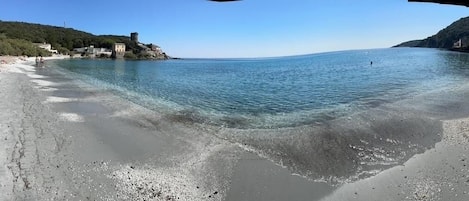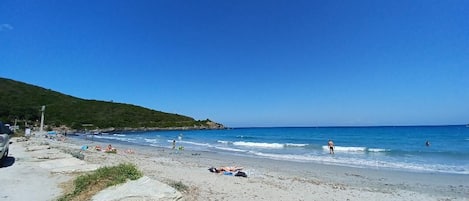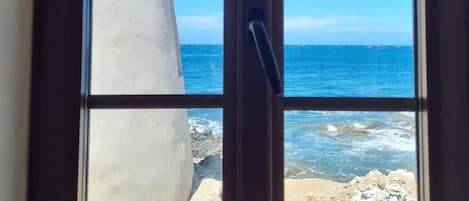Entire home
Duplex in the heart of the maquis with mountain views, Wi-Fi and air conditioning
Choose dates to view prices
Photo gallery for Duplex in the heart of the maquis with mountain views, Wi-Fi and air conditioning





Entire home
Popular amenities
- Parking available
- Kitchen
- Barbecue grill
- Air conditioning
- Outdoor space
- Free WiFi
Explore the area

Meria
- Plage de Meria1 min walk
- Porticciolo Marina9 min drive
- Tamarone Beach20 min drive
- Bastia (BIA-Poretta)87 min drive
Room options
About the area
Meria
Seaside stay .At this Meria vacation home, you'll be within half a mile (1 km) of Plage de Meria and 3 miles (5 km) of Plage de Macinaggio. Also, Corsica Beaches is within 3 miles (5 km) and Tamarone Beach is within 6 miles (10 km).
What's nearby
- Plage de Meria - 1 min walk - 0.1 km
- Plage de Macinaggio - 7 min drive - 4.1 km
- Porticciolo Marina - 9 min drive - 9.1 km
- Pietracorbara Beach - 18 min drive - 13.4 km
- Tamarone Beach - 20 min drive - 8.8 km
Getting around
- Bastia Station - 36 min drive
- Bastia (BIA-Poretta) - 87 min drive
Restaurants
- U Scalu - 4 min drive
- Tony Bar - 12 min drive
- U Paradisu - 10 min drive
- Restaurant A Macciotta - 22 min drive
- A Cantina - 6 min drive
About this property
Entire place
You'll have the entire home to yourself and will only share it with other guests in your party.
Duplex in the heart of the maquis with mountain views, Wi-Fi and air conditioning
This duplex in the heart of the maquis is located in Meria and offers a magnificent view of the mountains. this 55 m² house consists of a living room with a sofa bed for 2 people, a fully equipped kitchen, a bedroom and a bathroom and can therefore accommodate 4 people. Additional amenities include Wi-Fi, a TV, and air conditioning and mosquito nets for your comfort. A baby cot and high chair are also available. This vacation rental offers a private outdoor space with a garden, a balcony, a barbecue and an outdoor shower and several parking spaces.
In the middle of the maquis and yet less than 2km from the beach, come and discover our little paradise.
Built on a rocky ridge, at an altitude of 200 m, the village of Meria dominates its marina, which has no port.
The town is made up of seven districts: Aghia, Casale, Cortalina, Croce, Lingulina, Puggiale and Serdulacciu. Casale, the oldest, contains a chapel of the Sant'Erasmu brotherhood created in 1774 to replace a brotherhood founded in 1599, and which until 1923 provided remarkable processions to the Navy via the San Paolo church, particularly Good Friday with lanterns, crosses and embroidered banners.
The village has a Genoese tower and the Palazzu, a remarkable 14th century house with a drawbridge. This construction was saved from ruin around 1975. There is also the San Roccu church dating from the 17th century and which contains two listed works, one from the 1st century.
More than 1,000 m south of the village, in the middle of the maquis, are the ruins of the Santa Catarina chapel. A developed path provides access. Its departure towards the north is located in Campu (Luri) via the San Salvadore chapel “straddling” the two towns.
1,000 m southeast of the village are the remains of the village of Caraco, abandoned around 1925. This place included a San Sebastianu chapel and a dozen houses. Caraco (171 m above sea level) is reached by a path of approximately 1.5 km through maquis, starting from the village of Meria.
North of Caraco the places of San Guiseppe, San Giovanni and Santa Maria bear witness to the disappeared sanctuaries.
In the middle of the maquis and yet less than 2km from the beach, come and discover our little paradise.
Built on a rocky ridge, at an altitude of 200 m, the village of Meria dominates its marina, which has no port.
The town is made up of seven districts: Aghia, Casale, Cortalina, Croce, Lingulina, Puggiale and Serdulacciu. Casale, the oldest, contains a chapel of the Sant'Erasmu brotherhood created in 1774 to replace a brotherhood founded in 1599, and which until 1923 provided remarkable processions to the Navy via the San Paolo church, particularly Good Friday with lanterns, crosses and embroidered banners.
The village has a Genoese tower and the Palazzu, a remarkable 14th century house with a drawbridge. This construction was saved from ruin around 1975. There is also the San Roccu church dating from the 17th century and which contains two listed works, one from the 1st century.
More than 1,000 m south of the village, in the middle of the maquis, are the ruins of the Santa Catarina chapel. A developed path provides access. Its departure towards the north is located in Campu (Luri) via the San Salvadore chapel “straddling” the two towns.
1,000 m southeast of the village are the remains of the village of Caraco, abandoned around 1925. This place included a San Sebastianu chapel and a dozen houses. Caraco (171 m above sea level) is reached by a path of approximately 1.5 km through maquis, starting from the village of Meria.
North of Caraco the places of San Guiseppe, San Giovanni and Santa Maria bear witness to the disappeared sanctuaries.
Property manager
Holidu Hosts Gmbh
Languages
English, German, Italian
Similar properties

The village candy
The village candy
Meria
- Kitchen
- Washer
- Air conditioning
- Outdoor space
4.7 out of 5, Exceptional, 29 reviews
4.7
Exceptional
29 reviews

Small house in a pedestrian village in Corsica
Small house in a pedestrian village in Corsica
Brando
- Kitchen
- Washer
- Dryer
- Free WiFi
3.0 out of 5, 6 reviews
3.0
6 reviews

View on the Sea in Northern Corsican Cape
View on the Sea in Northern Corsican Cape
Luri
- Kitchen
- Washer
- Free WiFi
- Air conditioning
5.0 out of 5, Exceptional, 6 reviews
5.0
Exceptional
6 reviews

Résidence Villa Tyrrenia
Résidence Villa Tyrrenia
Rogliano
- Kitchen
- Pet-friendly
- Parking included
- Free WiFi
4.2 out of 5, Very good, 118 reviews
4.2
Very good
118 reviews

Villa Marine de Meria, completely renovated, 10 meters from the beach
Villa Marine de Meria, completely renovated, 10 meters from the beach
Meria
- Ocean view
- Kitchen
- Washer
- Free WiFi
5.0 out of 5, Exceptional, 2 reviews
5.0
Exceptional
2 reviews

Apartment 'Casa Du Lion 800m Mer Cap Corse' with Shared Terrace, Wi-Fi and Air Conditioning
Apartment 'Casa Du Lion 800m Mer Cap Corse' with Shared Terrace, Wi-Fi and Air Conditioning
Brando
- Kitchen
- Washer
- Pet-friendly
- Free WiFi

Modern villa with sea and mountain views Cap Corse
Modern villa with sea and mountain views Cap Corse
Sisco
- Kitchen
- Washer
- Free WiFi
- Air conditioning

Waterfront fisherman's cottage
Waterfront fisherman's cottage
Ersa
- Kitchen
- Washer
- Pet-friendly
- Air conditioning
4.5 out of 5, Wonderful, 20 reviews
4.5
Wonderful
20 reviews

Holiday rentals in Corsica
Holiday rentals in Corsica
Luri
- Washer
The price is CA $109
CA $109
CA $226 total
includes taxes & fees
May 11 - May 12

Tiny Loft, cocooning and farniente at Cap Corse
Tiny Loft, cocooning and farniente at Cap Corse
brando
- Hot tub
- Kitchen
- Washer
- Free WiFi
4.7 out of 5, Exceptional, 17 reviews
4.7
Exceptional
17 reviews
Property amenities
Beach
- Beach nearby
Internet
- Available in the house: Free WiFi
Parking and transportation
- Parking on site
Kitchen
- Coffee/tea maker
- Cookware, dishware, and utensils
- Dishwasher
- Microwave
- Oven
- Refrigerator
- Spices
- Stovetop
- Toaster
Bedrooms
- Bedroom
- Bedsheets provided
- Sofa bed
Bathroom
- Hair dryer
- Outdoor shower
- Shower
- Towels provided
Living spaces
- Living room
Entertainment
- TV
Outdoor areas
- Balcony
- Barbecue grill
- Garden
Comfort
- Air conditioning
- Heating
Pets
- No pets allowed
Suitability/Accessibility
- Smoke-free property
Services and conveniences
- Iron/ironing board
Location highlights
- In the mountains
- Near the sea
Things to do
- Cycling nearby
- Hiking/biking trails nearby
Safety features
- Carbon monoxide detector (host has indicated there is a carbon monoxide detector on the property)
- Smoke detector (host has indicated there is a smoke detector on the property)
- Fire extinguisher
General
- Garden
- Unit size: 592 square feet
Policies
Check-in
Check-in time starts at 4:00 PM
Check-out
Check-out before 10:00 AM
Special check-in instructions
You will receive an email from the host with check-in and check-out instructions
Pets
- No pets allowed
Children and extra beds
- Children are welcome.
Important information
You need to know
Extra-person charges may apply and vary depending on property policy
Government-issued photo identification and a credit card, debit card, or cash deposit may be required at check-in for incidental charges
Special requests are subject to availability upon check-in and may incur additional charges; special requests cannot be guaranteed
Parties and events are allowed on site
Host has indicated there is a carbon monoxide detector on the property
Host has indicated there is a smoke detector on the property
Safety features at this property include a fire extinguisher
This property is managed through our partner, Vrbo. You will receive an email from Vrbo with a link to a Vrbo account, where you can change or cancel your reservation
Charges for extra guests may apply and vary according to property policy.
A cash deposit, credit card, or debit card for incidental charges and government-issued photo identification may be required upon check-in.
Special requests are subject to availability at the time of check-in. Special requests can't be guaranteed and may incur additional charges.
A cash deposit, credit card, or debit card for incidental charges and government-issued photo identification may be required upon check-in.
Special requests are subject to availability at the time of check-in. Special requests can't be guaranteed and may incur additional charges.
- This property is managed by a professional host. The provision of housing is linked to their trade, business, or profession. Parties and events are allowed on site. For guests' safety, the property includes a carbon monoxide detector, a fire extinguisher, and a smoke detector in each accommodation.
We should mention
- Onsite cash transactions can't exceed EUR 1000, due to national regulations. For more details, please contact the property using information in the booking confirmation.
Property is also known as
56971341
Duplex in the heart of the maquis with mountain views, Wi-Fi and air conditioning Reviews
Reviews
Rating 10 - Excellent. 0 out of 0 reviews
10 - Excellent
0
Rating 8 - Good. 0 out of 0 reviews
8 - Good
0
Rating 6 - Okay. 0 out of 0 reviews
6 - Okay
0
Rating 4 - Poor. 0 out of 0 reviews
4 - Poor
0
Rating 2 - Terrible. 0 out of 0 reviews
2 - Terrible
0
Reviews
No reviews yet
Be the first to leave a review for this property after your stay.